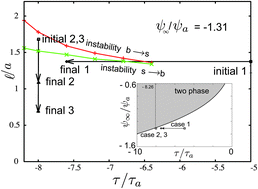Hydrodynamics in bridging and aggregation of two colloidal particles in a near-critical binary mixture
Abstract
We investigate bridging and aggregation of two colloidal particles in a near-critical binary mixture when the fluid far from the particles is outside the coexistence (CX) curve and is rich in the component disfavored by the colloid surfaces. In such situations, the adsorption-induced interaction is enhanced, leading to bridging and aggregation of the particles. We realize bridging firstly by changing the temperature with a fixed interparticle separation and secondly by letting the two particles aggregate. The interparticle attractive force dramatically increases upon bridging. The dynamics is governed by hydrodynamic flow around the colloid surfaces. In aggregation, the adsorption layers move with the particles and squeezing occurs at narrow separation. These results suggest relevance of bridging in the reversible colloid aggregation observed so far. We use the local functional theory [J. Chem. Phys., 2012, 136, 114704] to take into account the renormalization effect and the simulation method [Phys. Rev. Lett., 2000, 85, 1338] to calculate the hydrodynamic flow around the colloidal particles.


 Please wait while we load your content...
Please wait while we load your content...